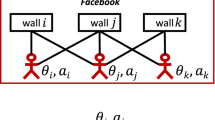Abstract
In this paper, we introduce homophily to a game-theoretic model of collective action (e.g., protests) on Facebook and study the effect of homophily in individuals’ willingness to participate in collective action, i.e., their thresholds, on the emergence and spread of collective action. We use three different networks (a real Facebook network, an Erdős–Rényi random graph, and a scale-free network) and conduct computational experiments to study contagion dynamics (the size and the speed of diffusion) with respect to the level of homophily. We provide a series of parametric results on the time to achieve a specified contagion spread, on the spread of contagion at different times, and the probability of cascades. We demonstrate that these behaviors are highly nonlinear and nonmonotonic in homophily. Networks with randomly assigned thresholds result in both smaller and slower diffusion compared to the networks characterized by homophily and heterophily.











Similar content being viewed by others
Notes
Two disjoint sets of nodes such that nodes within the same set are not connected; but are connected to all nodes in the other set. Consider two sets of nodes; M and L, and let m and l denote the sizes of these sets, respectively. A complete bipartite graph, \(K_{m,l}\), is a bipartite graph that has each vertex from one set of nodes, say M, adjacent to each vertex in the other set, L. For example, \(m=1, l>1\) corresponds to a star, and \(m=2,l=2\) is a square graph.
References
Anagnostopoulos A, Kumar R, Mahdian M (2008) Influence and correlation in social networks. In: KDD, pp 7–15
Aral S, Muchnik L, Sundararajan A (2013) Engineering social contagions: optimal network seeding in the presence of homophily. Netw Sci 1:125–153
Axelrod R (1997) The dissemination of culture: a model with local convergence and global polarization. J Conf Resolut 41:203–226
Bischi G, Merlone U (2009) Global dynamics in binary choice models with social influence. J Math Sociol 33:277–302
Boyd R, Richerson PJ (2002) Group beneficial norms can spread rapidly in a structured population. J Theor Biol 215(3):287–296
Centola D (2011) An experimental study of homophily in the adoption of health behavior. Science 1269:1269–1272
Centola DM (2013) Homophily, networks, and critical mass: solving the start-up problem in large group collective action. Ration Soc 25(1):3–40
Centola D, Macy M (2007) Complex contagions and the weakness of long ties. Am J Soc 113(3):702–734
Centola D, Gonzalez-Avella JC et al (2007) Homophily, cultural drift, and the co-evolution of cultural groups. J Confl Resolut 51:905–929
Chiang YS (2007) Birds of moderately different feathers: bandwagon dynamics and the threshold heterogeneity of network neighbors. J Math Sociol 31(1):47–69
Chwe MSY (2000) Communication and coordination in social networks. Rev Econ Stud 67:1–16
Flache A, Macy MW (2011) Local convergence and global diversity: from interpersonal to social influence. J Confl Resolut 55(6):970–995
Golub B, Jackson MO (2012) How homophily affects the speed of learning and best response dynamics. Q J Econ 127:1287–1333
Gonzalez-Bailon S, Borge-Holthoefer J, Rivero A, Moreno Y (2011) The dynamics of protest recruitment through an online network. Nat Sci Rep 1:197
Granovetter M (1973) The strength of weak ties. Am J Sociol 78(6):1360–1380
Granovetter M (1978) Threshold models of collective behavior. Am J Soc 83(6):1420–1443
Jackson MO, Lopez-Pintado D (2013) Diffusion and contagion in networks with heterogeneous agents and homophily. Netw Sci 1:49–67
Korkmaz G, Kuhlman CJ, Marathe A, Marathe MV, Vega-Redondo F (2014) Collective action through common knowledge using a Facebook model. In: AAMAS
Korkmaz G, Kuhlman CJ, Goldstein J, Redondo FV (2018) A model of homophily, common knowledge and collective action through facebook. In: 2018 IEEE/ACM international conference on advances in social networks analysis and mining (ASONAM). IEEE, pp 409–412
Lewis R (1969) Convention: a philosophical study. Harvard University Press, Cambridge
McPherson JM, Smith-Lovin L, Cook JM (2001) Birds of a feather: homophily in social networks. Annu Rev Sociol 27:415–444
Prakash BA, Chakrabarti D, Faloutsos M, Valler N, Faloutsos C (2011) Threshold conditions for arbitrary cascade models on arbitrary graphs. In: Proceedings of the 11th IEEE conference on data mining (ICDM 2011), pp 537–546
Romero D, Meeder B, Kleinberg J (2011) Differences in the mechanics of information diffusion. In: WWW
Schelling T (1960) The strategy of conflict. Harvard University Press, Cambridge
Schelling T (1978) Micromotives and macrobehavior. W. W. Norton and Company, New York
Siegel D (2009) Social networks and collective action. Am J Polit Sci 53:122–138
Viswanath B, Mislove A, Cha M, Gummadi KP (2009) On the evolution of user interaction in Facebook. In: WOSN
Watts D (2002) A simple model of global cascades on random networks. PNAS 99(9):5766–5771
Acknowledgements
This material is based upon work supported by the Air Force Office of Scientific Research under award number FA9550-17-1-0378. Any opinions, finding, and conclusions or recommendations expressed in this material are those of the author(s) and do not necessarily reflect the views of the U.S. Air Force.
Author information
Authors and Affiliations
Corresponding author
Additional information
Publisher's Note
Springer Nature remains neutral with regard to jurisdictional claims in published maps and institutional affiliations.
A preliminary version of the paper appeared in the Proceedings of 2018 IEEE/ACM International Conference on Advances in Social Networks Analysis and Mining (Korkmaz et al. 2018).
Rights and permissions
About this article
Cite this article
Korkmaz, G., Kuhlman, C.J., Goldstein, J. et al. A computational study of homophily and diffusion of common knowledge on social networks based on a model of Facebook. Soc. Netw. Anal. Min. 10, 5 (2020). https://doi.org/10.1007/s13278-019-0615-5
Received:
Revised:
Accepted:
Published:
DOI: https://doi.org/10.1007/s13278-019-0615-5




